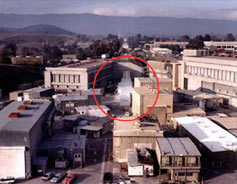
Handy Links
SLAC News Center
SLAC Today
- Subscribe
- Archives: Feb 2006-May 20, 2011
- Archives: May 23, 2011 and later
- Submit Feedback or Story Ideas
- About SLAC Today
SLAC News
Lab News
- Interactions
- Lightsources.org
- ILC NewsLine
- Int'l Science Grid This Week
- Fermilab Today
- Berkeley Lab News
- @brookhaven TODAY
- DOE Pulse
- CERN Courier
- DESY inForm
- US / LHC
SLAC Links
- Emergency
- Safety
- Policy Repository
- Site Entry Form

- Site Maps
- M & O Review
- Computing Status & Calendar
- SLAC Colloquium
- SLACspeak
- SLACspace
- SLAC Logo
- Café Menu
- Flea Market
- Web E-mail
- Marguerite Shuttle
- Discount Commuter Passes
-
Award Reporting Form
- SPIRES
- SciDoc
- Activity Groups
- Library
Stanford
Around the Bay
Looking Back on the FFTB
 The Final Focus Test Beam (FFTB) saw its last beam during the early hours of Monday, April 10.
The FFTB will now be removed to make way for the Linac Coherent Light Source (LCLS).
The Final Focus Test Beam (FFTB) saw its last beam during the early hours of Monday, April 10.
The FFTB will now be removed to make way for the Linac Coherent Light Source (LCLS).
For 13 years, this long concrete building housed a remarkable experimental facility that first proved it was possible to create nanometers-thin beams for future colliders. The FFTB then went on to host more than two dozen cutting-edge experiments and test beams, none of which were envisioned when the FFTB was first built.
The FFTB was designed and built by an international collaboration that included the Budker Institute-Novosibirsk, DESY, KEK, LAL-Orsay, Max Planck Institute-Munich, Kawasaki, University of Rochester, IBM and Fermilab. Operations began in 1993.
The "final focus" in Final Focus Test Beam refers to the precise focusing of the electron and positron beams that occurs in the last meters of an accelerator before the collision point. The FFTB demonstrated the ability to measure and control a beam with a spot size (cross section) of only 60 nanometers: one-tenth the wavelength of visible light and 250 times smaller than the beam in the linac.
"We came within 10 percent of our goals in the first runs," said David Burke, who headed the project. "The FFTB realized two important goals: encouraging international participation in the new linear collider project and developing technology for the relevant beam qualities."
The properties of the FFTB beam have also made possible a number of novel experiments and tests that could not be done anywhere else in the world. These include plasma lens and plasma wakefield experiments, fast pulse magnetic switching, non-linear Compton scattering, ultrafast x-ray experiments (SPPS), cosmic ray shower studies, and searches for microwave signals from neutrinos.
—Heather Rock Woods SLAC Today, April 11, 2006
Image: The FFTB (circled in red), a 100-meter extension from the end of the linac, has been an integral part of the Research Yard for over a decade.